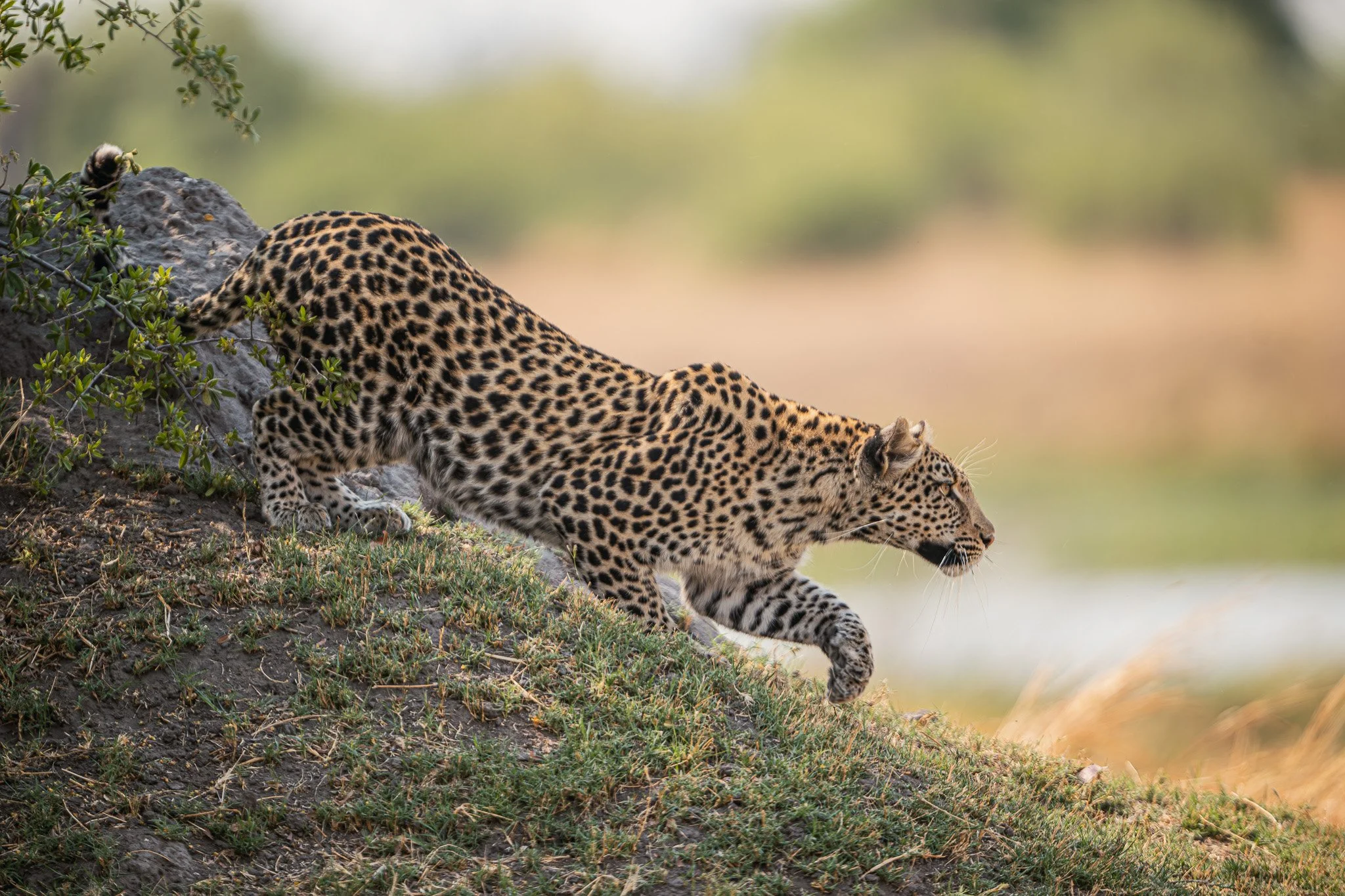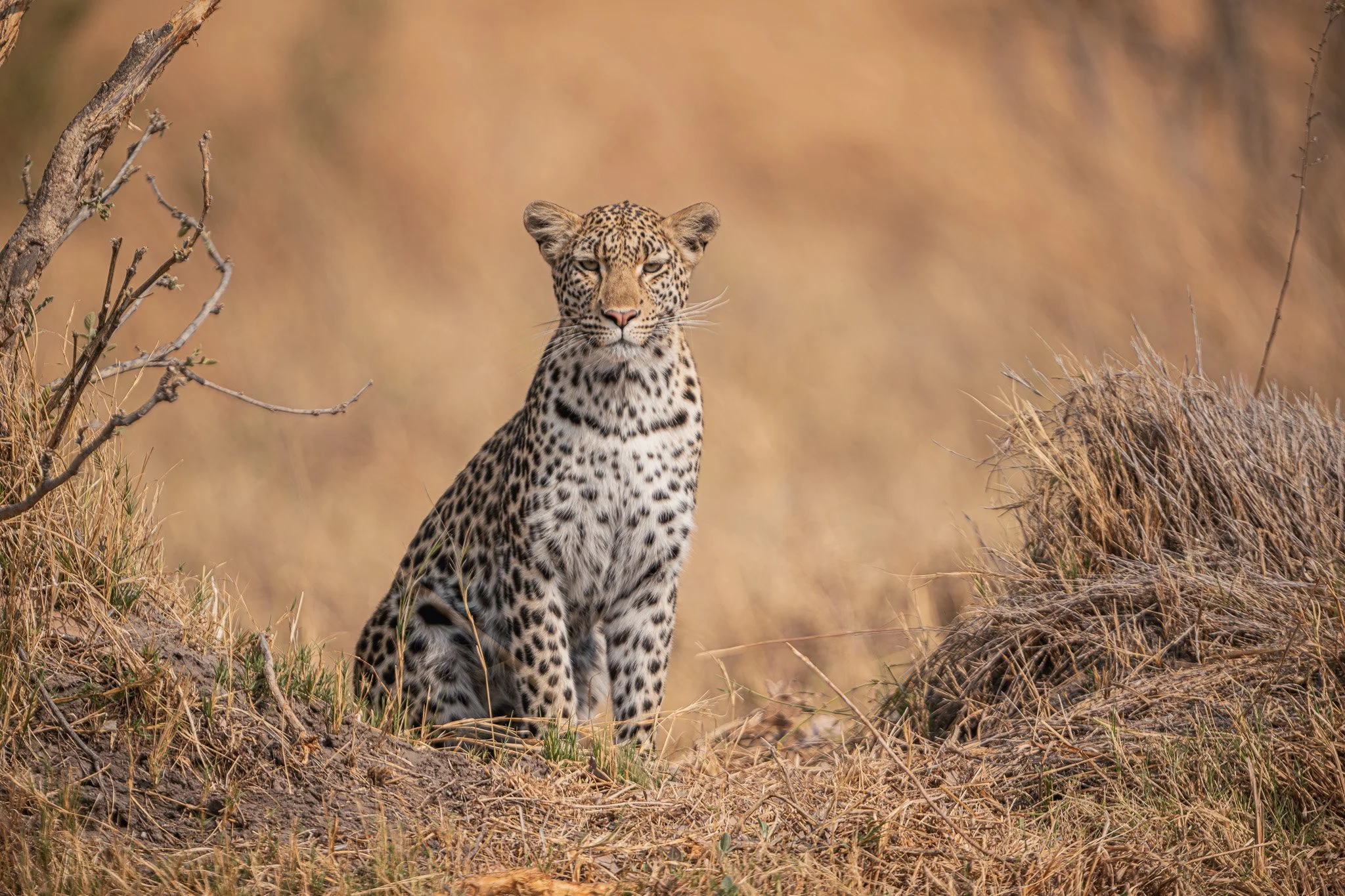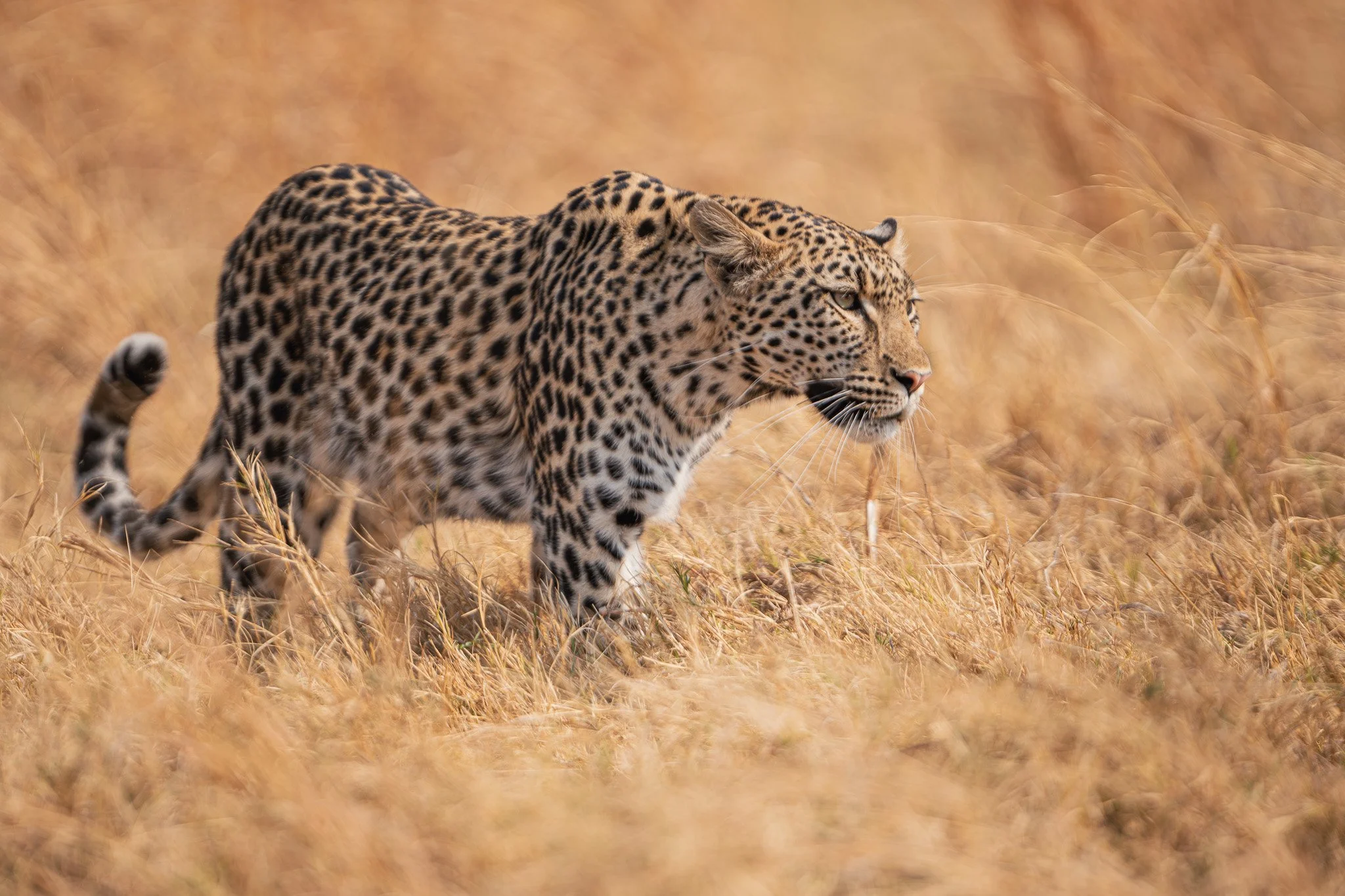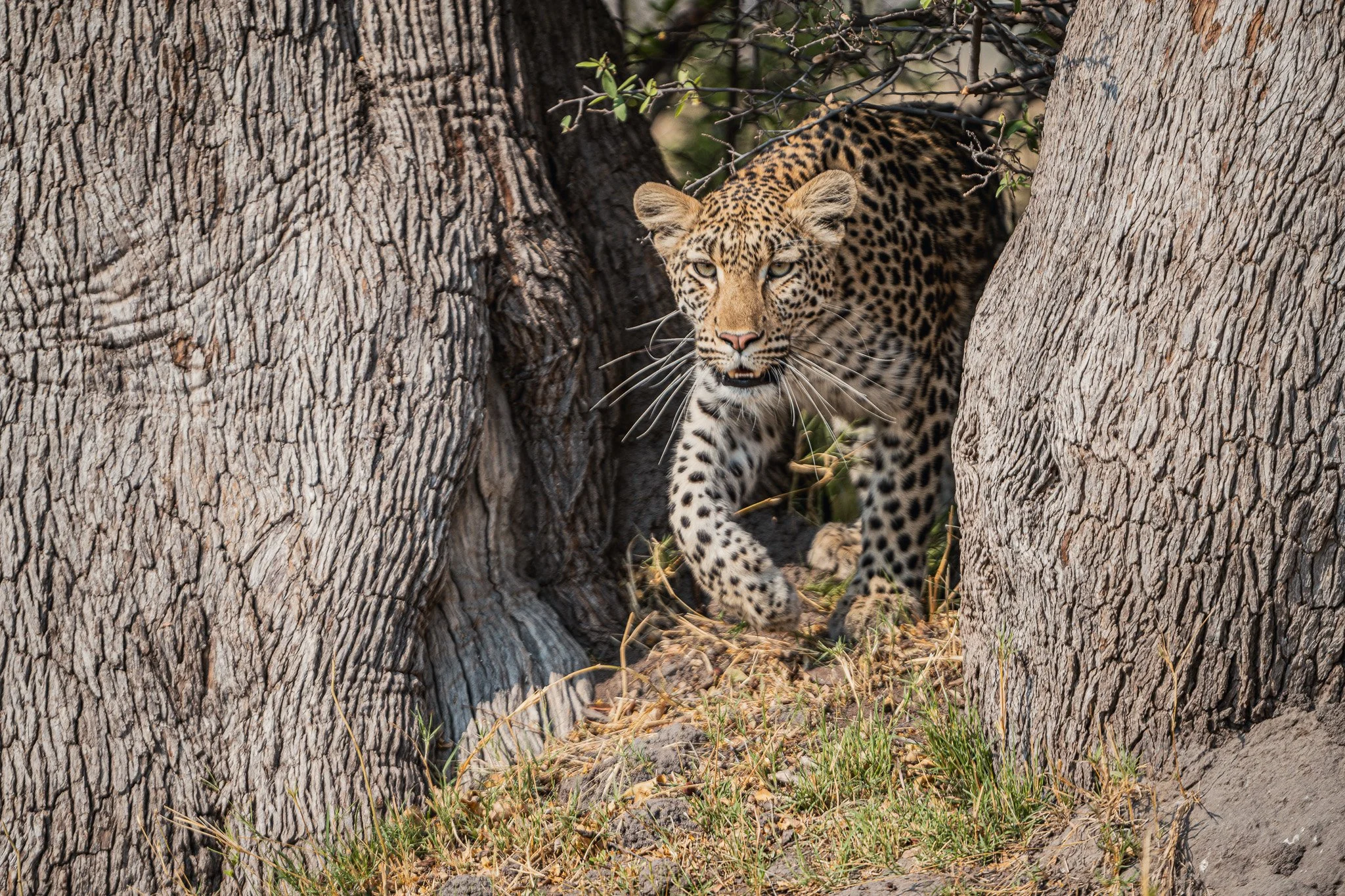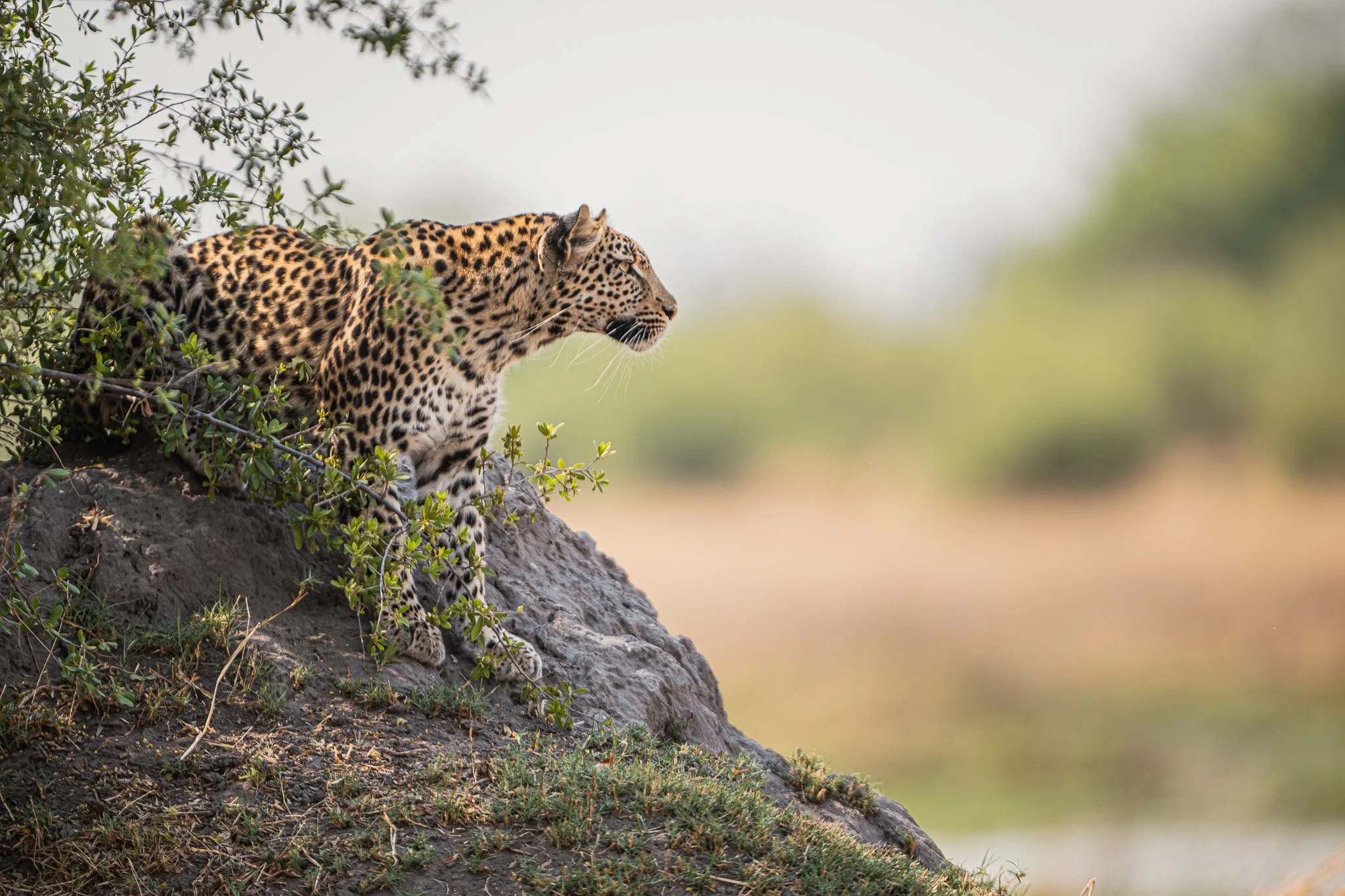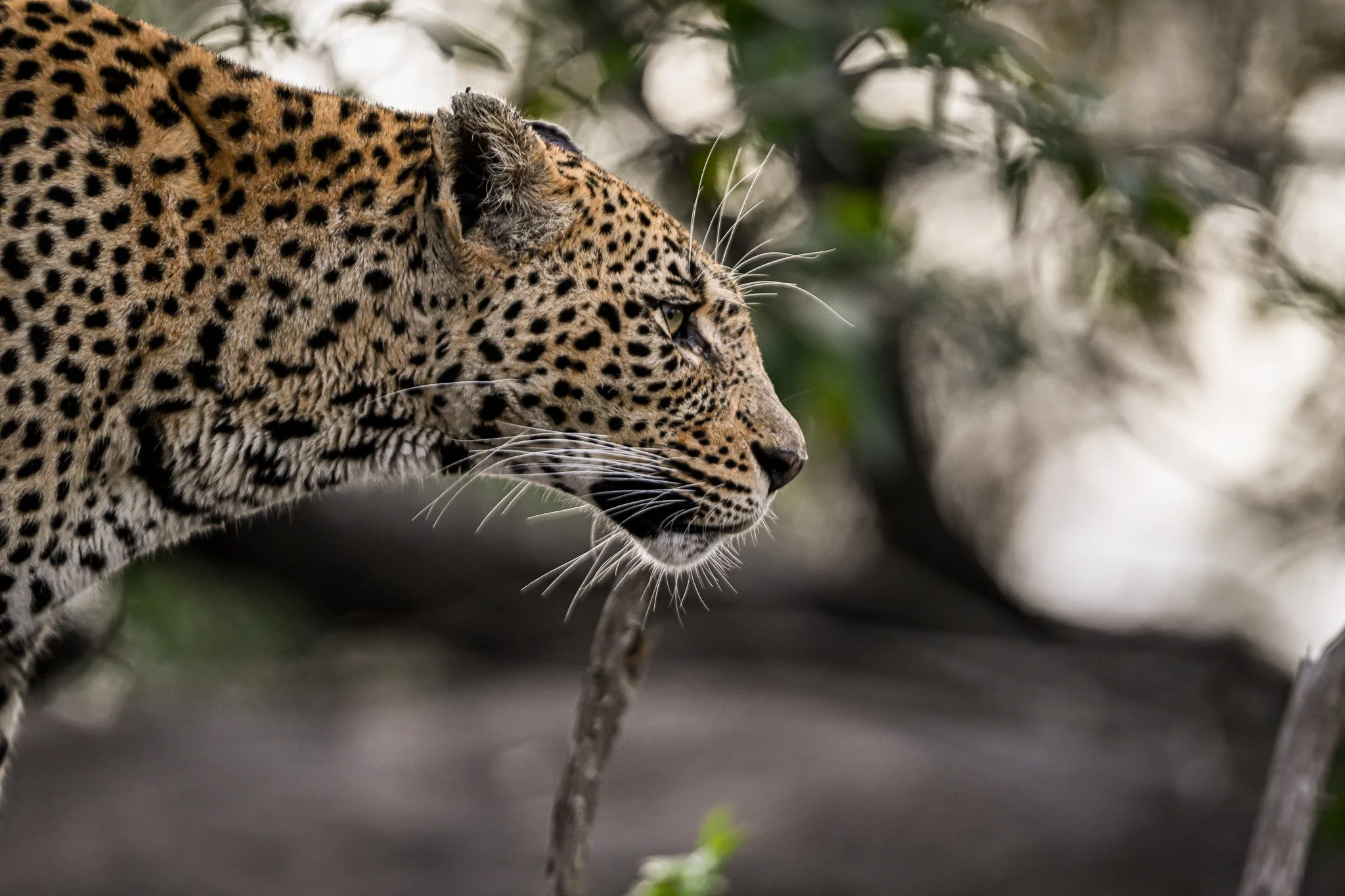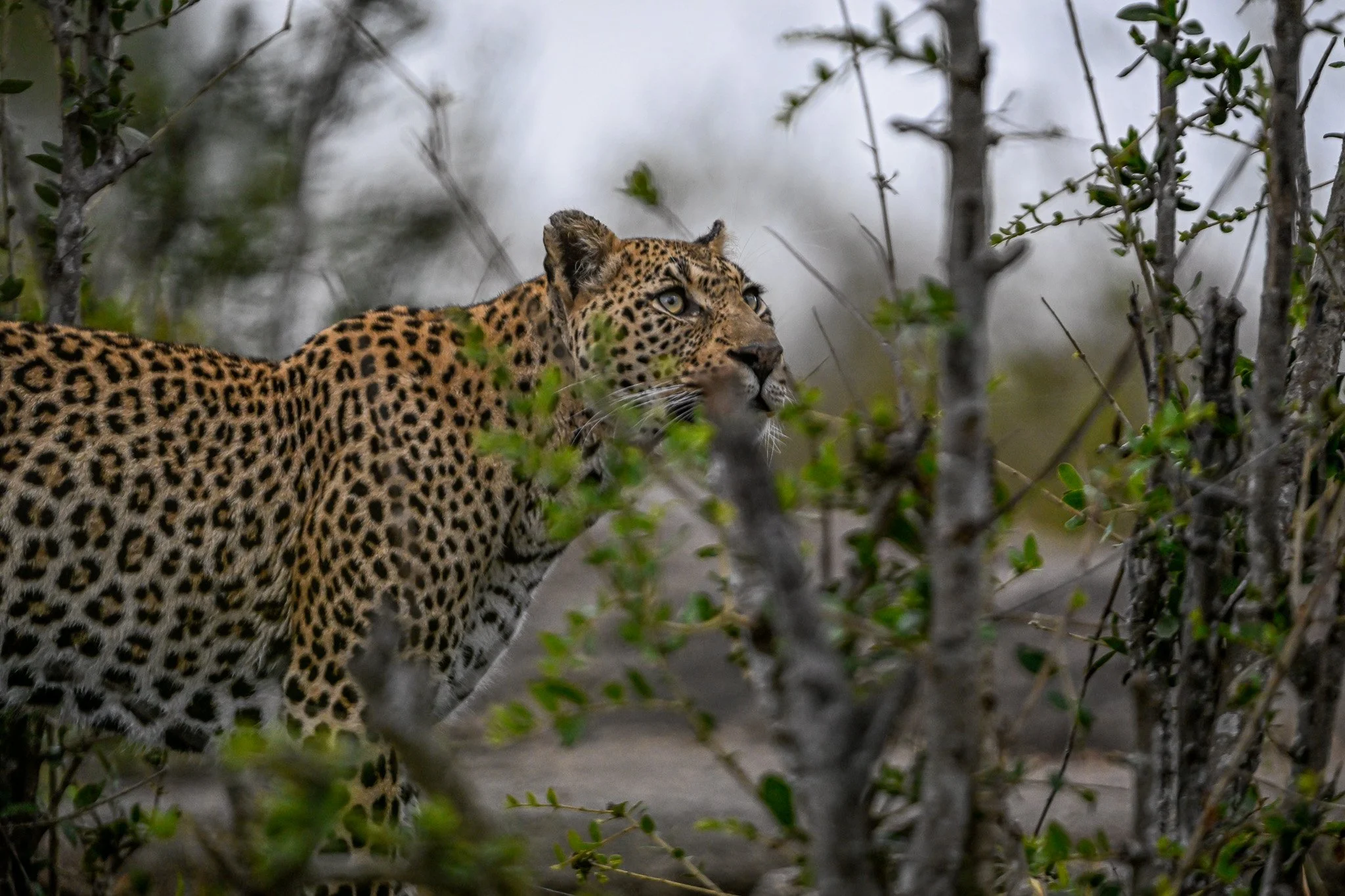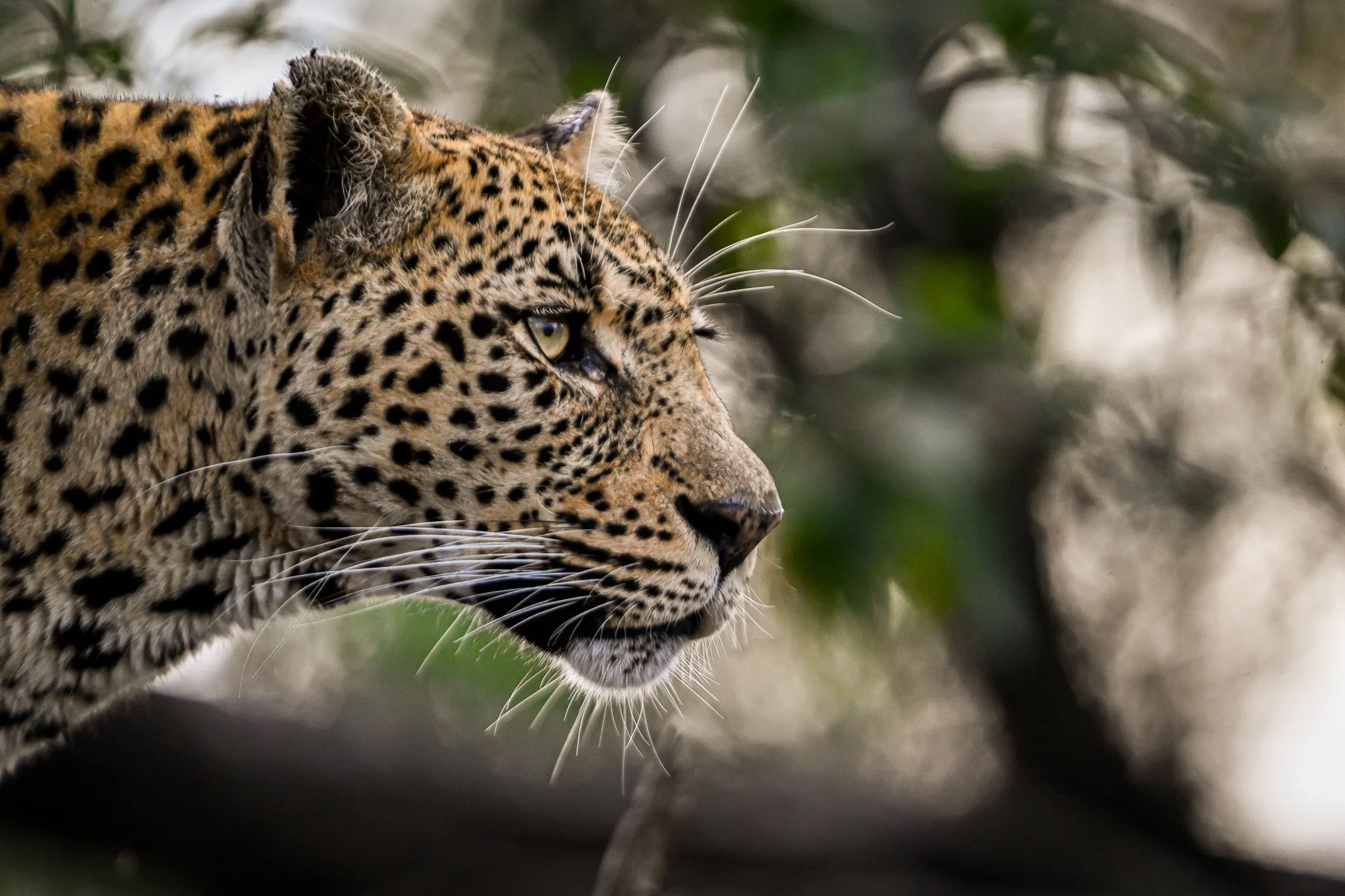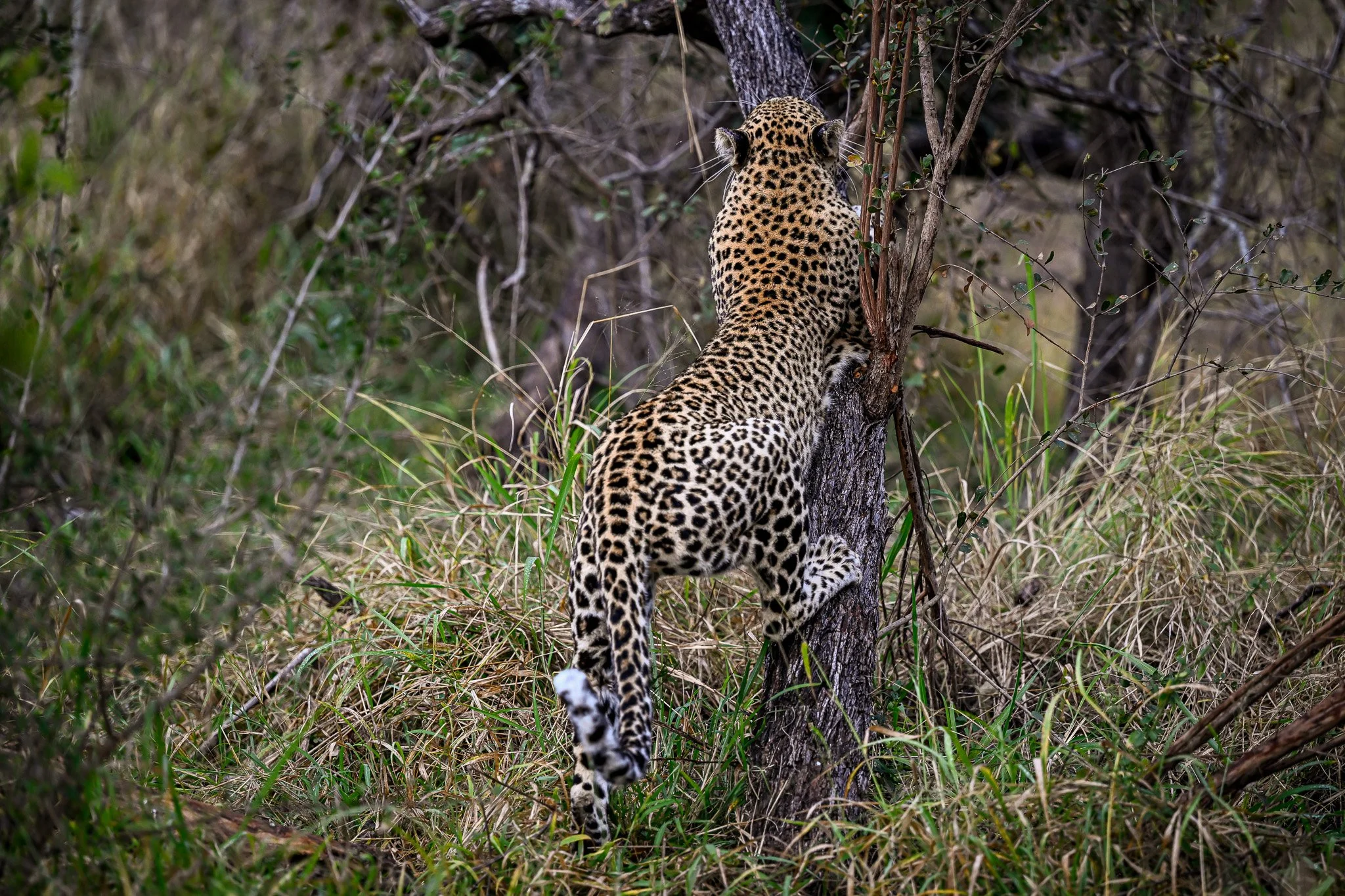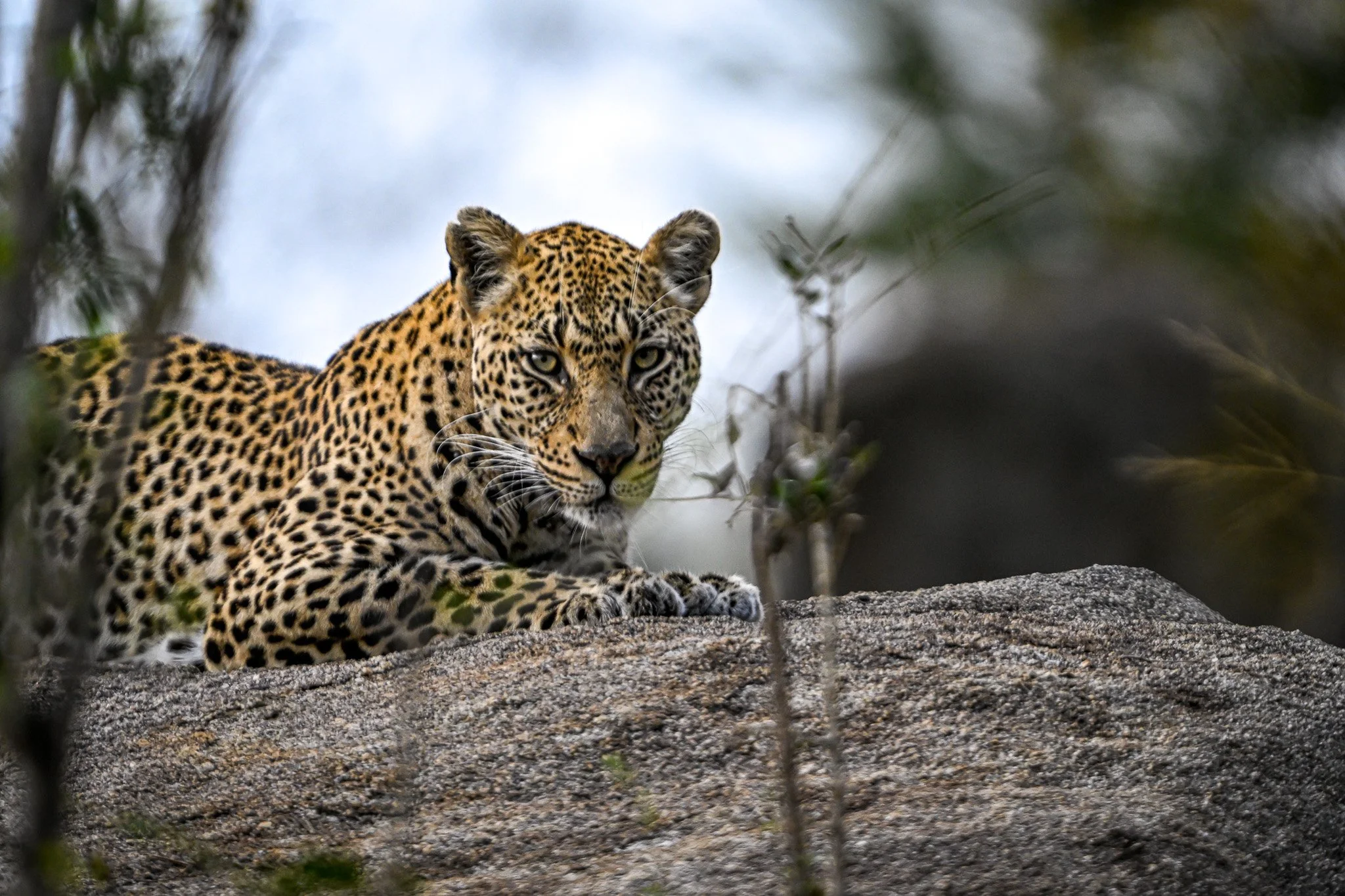Wildlife Blog
Leopardess in the Okavango
An eighteen month old leopardess begins her journey of independence with a very ambitious impala hunt in Botswana’s Okavango Delta…
The Okavango Delta in Botswana is an ecosystem teeming with wildlife, providing an abundance of exceptional sightings for its visitors. With so much variety within the habitat, from wetlands to woodlands, the Okavango offers a diverse collection of species, big and small.
My favorite species to search for on safari is the ever elusive leopard. The morning radio chatter has us heading towards a mating pair, nestled comfortably in a dense bush. Guided by the guttural sound of the pair, we are able to find the exact bush they’re hidden in, even catching a quick glimpse of that distinctive rosette pattern.
Even though the leopards were actively mating when we pulled up, they were done by the time we positioned our car. Leopards will mate for only a few seconds, every fifteen minutes, for a few days at a time. So, we wait for a few minutes, see the tiniest bit of movement, hear the female growl, and know that they have once again mated.
After sitting with the leopards for over an hour, they begin to tire and slow down as the temperature rises. We decide to leave them and see if we can find anything else in the area.
Not too far away, we stumble upon a young leopardess, who happens to be the daughter of the mating female. Banda, my guide for the week, says the young female is approximately a year and a half of age, suggesting that she is just starting to venture off on her own.
Oftentimes, a mother leopard will give her daughter a small portion of her own territory. This provides the kin with a safe place for her to start her independent life. And as she matures and becomes more comfortable in the wild, she will begin the process of expanding her territory.
This young female is striding confidently through the tall grass, when all of a sudden she slows and lowers herself to the ground. She has spotted a herd of impala in the distance. Leopards are opportunistic hunters, and will feast on everything from rodents and birds to their preferred antelope.
But to see an eighteen month old leopard, who is just beginning her independent journey in the wild, take on such an ambitious hunt was absolutely incredible.
She knows to stay low and hidden — the camouflage coat of a leopard allows them to go unnoticed when they make use of cover. She utilizes bushes, tall grasses, and will even climb trees in an effort to shadow her prey.
Leopards hunt by ambushing or stalking their prey. Regardless of which approach they take, it is essential that they stay hidden and are patient, waiting for the prey to come within an appropriate distance for the individual to pounce, claw, and bite, until they take the target down.
Our cat is taking her time, slowly creeping from bush to bush as the impala leave the watering hole, and head inland. They are alert, but don’t seem to suspect that they are being stalked. She watches over the herd from a nearby tree, waiting for the perfect opportunity… Once the antelope begin to relax and focus their attention on grazing, she gets up from her branch and leaps down the trunk of the tree.
Unfortunately, even though her movement is impressively swift, a nearby bird spots the leopard and voices an alarm call, notifying the impala (and every other nearby animal) of the big cat’s presence. The whole herd scatters, running away to safer grounds.
We leave her as the afternoon approaches. She’ll rest during the heat of the day, under cover, in an effort to stay cool, and attempt another hunt in the evening to satisfy her lingering hunger. Despite their athleticism and stalking skills, most leopard hunts are not successful. These cats have an estimated success rate of about twenty percent, though it differs depending on the individual and location.
Although I would’ve been thrilled to see this young leopardess secure a hearty lunch for herself as she begins this new life of independence, I am always awestruck when I encounter these incredible cats. They exude confidence, courage, and intellect. Not to mention, they might be one of the most stunning species in the animal kingdom.
Leopards in Mala Mala
Powerful, stealthy, and infamously elusive…
Powerful, stealthy, and infamously elusive. The leopard is one of the most difficult species to spot on safari. They are solitary animals, predominantly nocturnal, and that unmistakable coat is perfect camouflage in the dense African bush. Despite never having a great sighting in my many African adventures, they remain my favorite species with their strong stature and intense stare. Yearning for a more intimate leopard encounter this trip, my dad and I journeyed to Mala Mala, a private game reserve within Sabi Sands, recognized for its substantial leopard population.
Leopards tend to be nomadic, which contributes to the challenge of finding them. They are regularly on the move within a defined range, excluding mothers, who are forced to abandon this nomadic lifestyle whilst their offspring are too young to accompany them. Rather than risking the safety of the kin, they’ll utilize den sites that offer protection to the cubs, often inaccessible to threats. These sites may look like hidden rock clefts, fallen trees, or even termite mounds. This den isn’t exactly “home”; the mother will hide the cubs in different concealed locations, moving from one safe space to the next, until they are strong enough to travel with her (usually around three months of age).
We were the first vehicle out before sunrise. Our ranger, Jaco, was unparalleled in his effort to show us all Mala Mala had to offer. No one drives a Land Rover quite like Jaco; he maneuvers through the overgrown African thicket with intention and ease. When we pulled into the forest, he began to slow, gently passing us branches overhead that would have otherwise taken us out. Every now and then, he’d accelerate allowing the vehicle to proceed haphazardly over the ground, heavily ornamented with bulky rocks and fallen branches.
The mother and cub were last seen together the previous day at the den site where we were headed. Trees towered high over the rock formation where the cub would be tucked away. As we waited quietly by the den with our eyes and ears peeled, the sun began to poke through the clouded sky. The woodlands were foggy from the rain that had showered the reserve before dawn, and while our visibility was hindered from the abundance of trees surrounding us, even the slightest sound was amplified.
Jaco perked up at the muffled sound of a distant, raspy cough. The noise was repeated every few seconds – a contact call. Leopards have distinctive calls, allowing the mother to communicate to her cub that she is returning to the den. Off to our left, she emerged from the woods – a strong figure moving slowly with her head held low. She continued to chuff as she passed in front of the truck, leaping onto a boulder just feet away from us. She scanned the site, as her calls got progressively louder.
Moments later, it became clear that this nine-year-old female was beginning to worry. Leopards are typically wary of their volume as to not expose their location to others, but this agitated mom didn’t seem concerned about her vociferous calls. The panic in her eyes exposed her realization…
Young leopards are notoriously inquisitive, and this particular cub had a reputation for being adventurous and wandering outside the den while his mom was gone. Mothers may leave the den site for up to two days. This time can be used to find food and patrol the land, while also allowing them to keep active and stay fit, ensuring their cubs have the best chance of survival.
As previously mentioned, it had down-poured that morning before we left camp. On our way to the den, we followed male leopard tracks that were shaped after the rainfall. This male was not the cub’s father, which may indicate trouble for the young leopard.
Each individual has a home range, marked by urine and claw marks on tree bark. Males have a larger home territory that will often overlap with the range of several females. Known for being territorial creatures, leopards will often fight to defend their terrain against individuals of the same sex. Because we trailed the male’s tracks to the site of the den, it is likely that he came across the cub, who was not his kin, and committed infanticide. This is a relatively common reproductive strategy that polygamous mammals may engage in, in the interest of eliminating the offspring of competing males.
Unfortunately, only about one-fifth of leopard cubs make it to adulthood in this area. Knowing this, we sat in the Land Rover without a sound as the grieving mother continued to cry out, wandering out of the den site and through the woodland trees. She briefly stopped at a branch, catching her breath and stretching her legs before continuing. Something told me she wasn’t ready to give up just yet.
Although this story is somber, I feel it's important to share. Leopards are the strongest cats in Africa, capable of carrying three times their body weight and hauling hundred-pound carcasses up trees. Regardless, sometimes the strongest animals are the most vulnerable.

